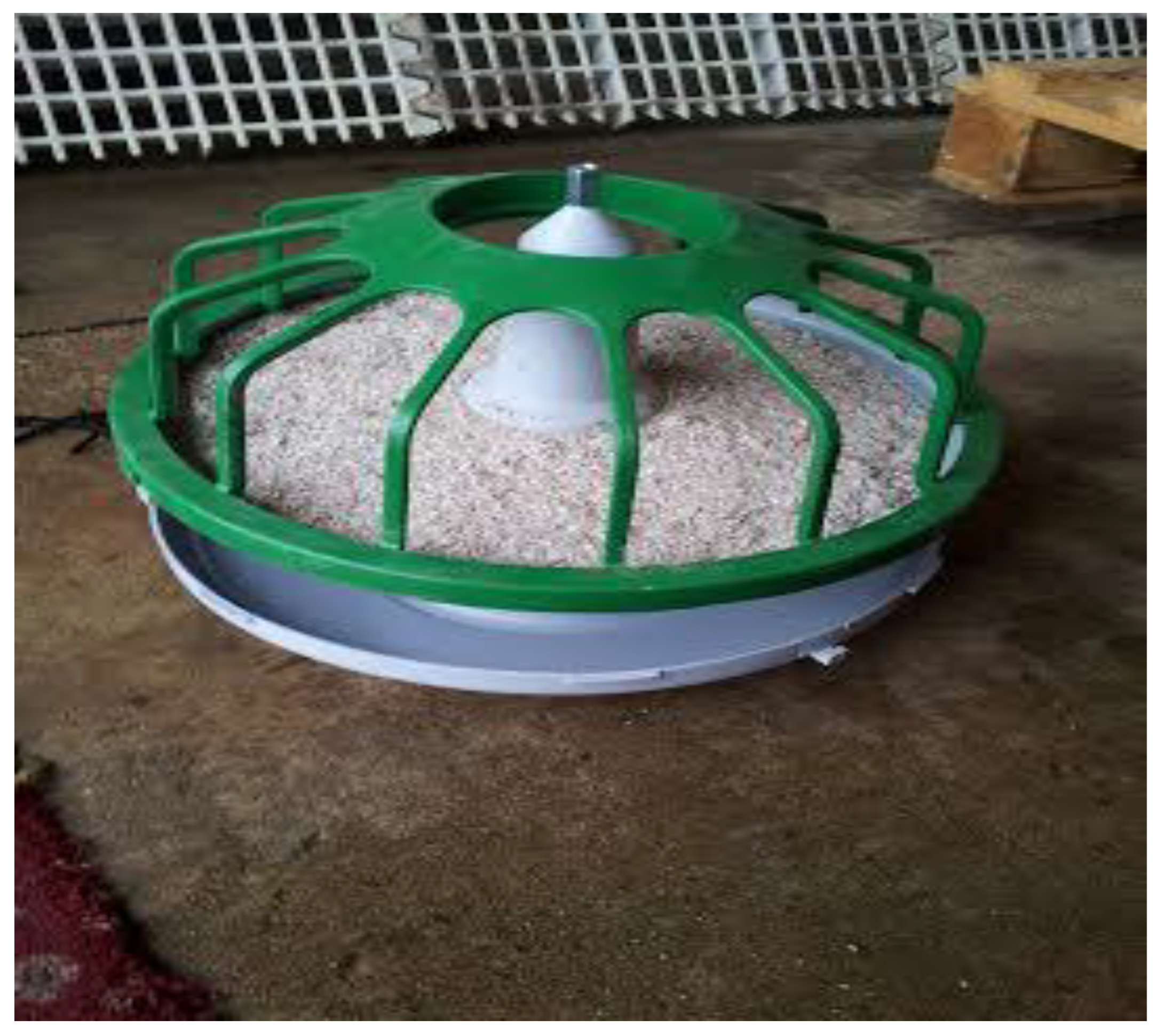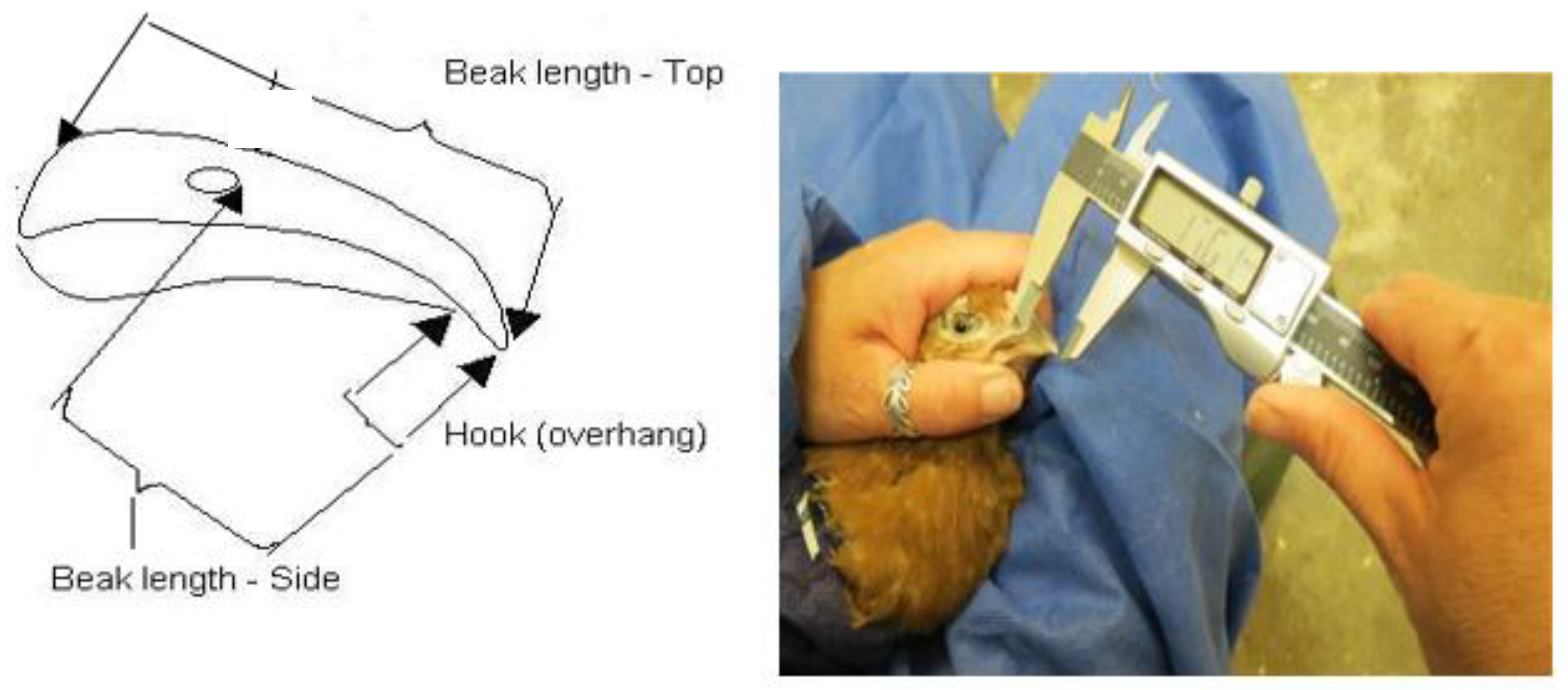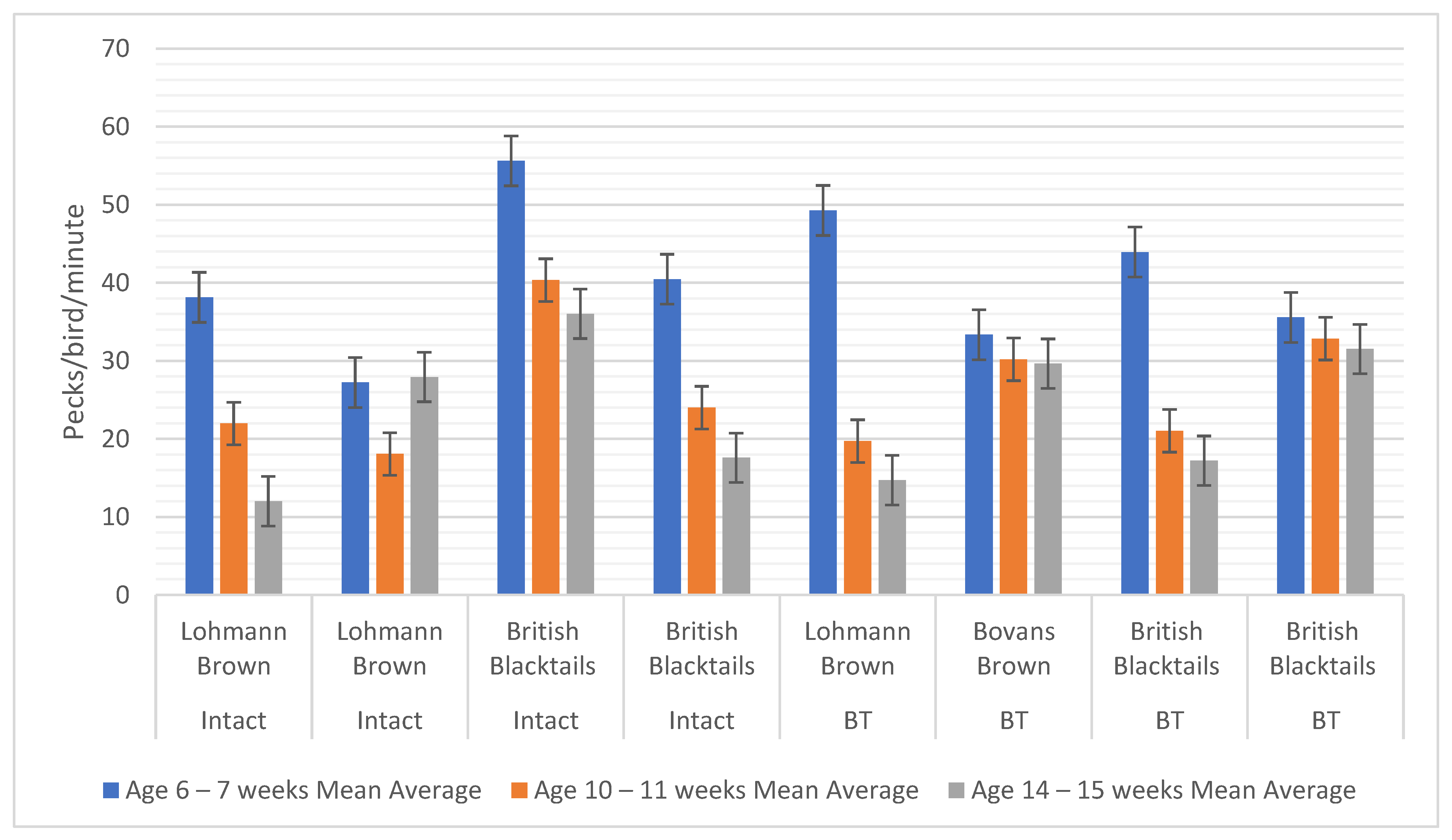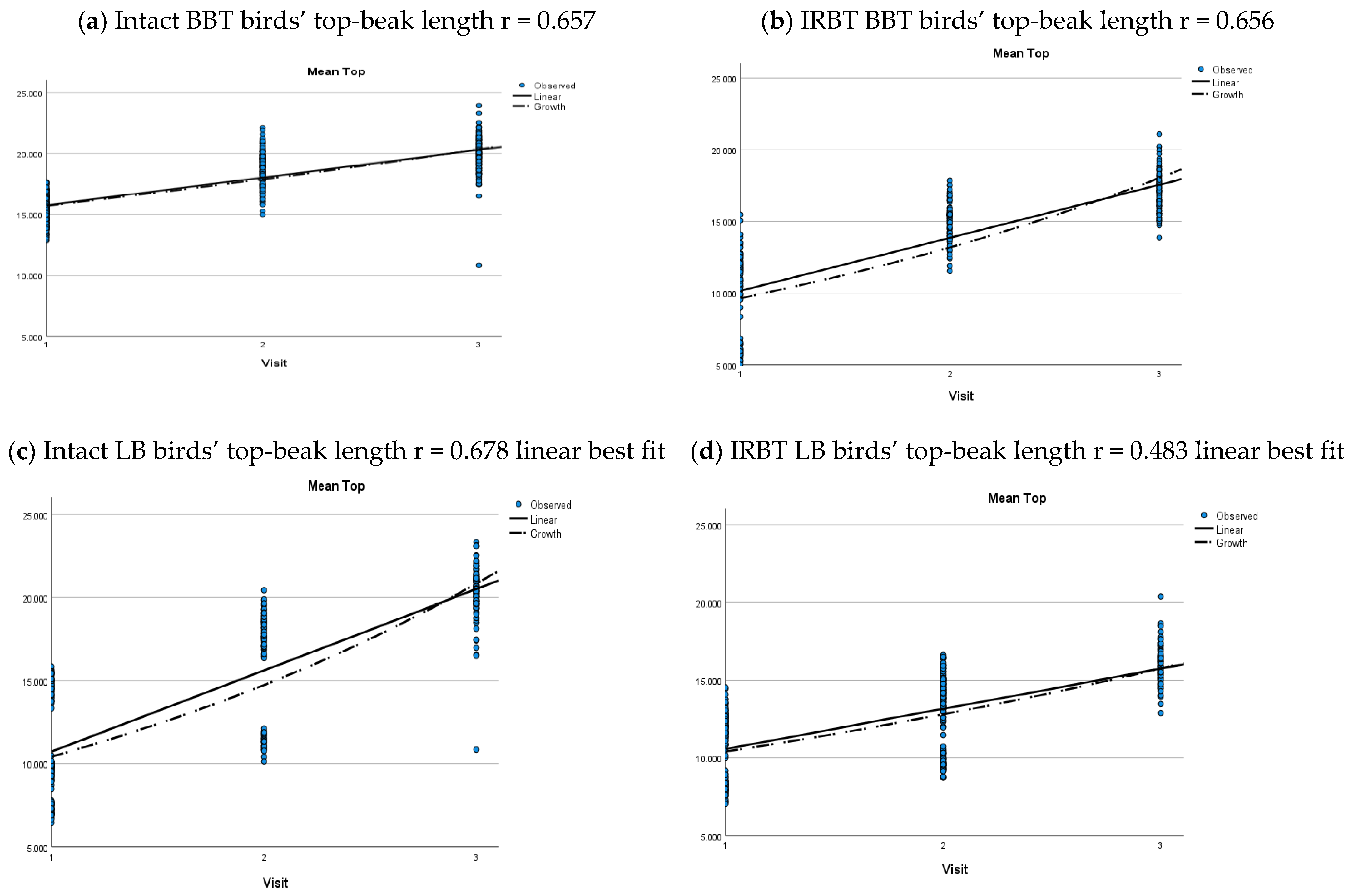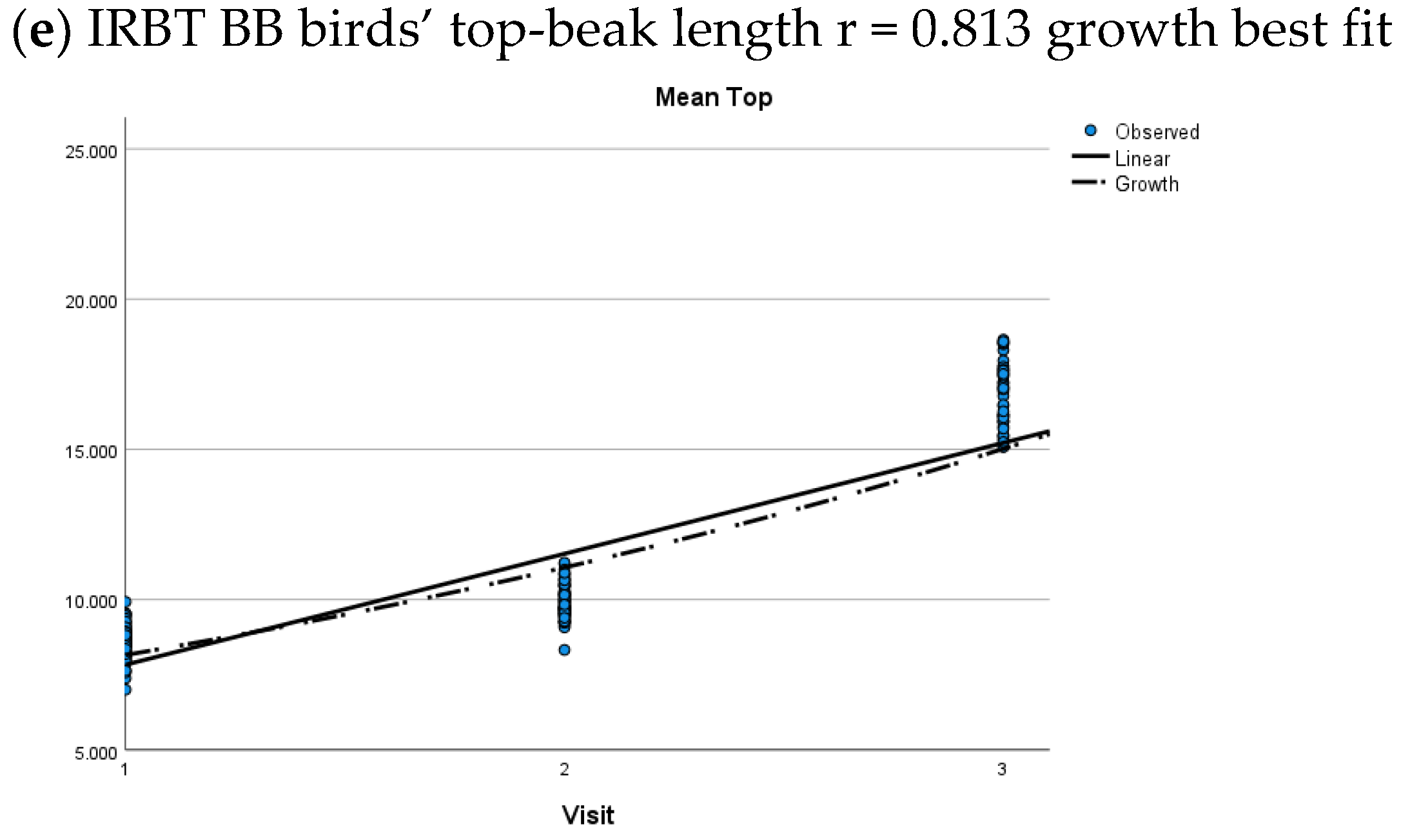1. Introduction
Injurious pecking (IP) is an umbrella term for inter-bird pecking behaviours including severe feather pecking (SFP), vent pecking (VP), cannibalistic pecking (CP) and toe pecking (TP) [
1]. The forceful pulling of feathers of conspecifics that occurs during SFP not only causes pain and distress [
2] but can lead to substantial feather loss and be associated with cannibalistic behaviour, vent pecking and a decline in egg production [
1,
2] as well as disease and high mortality [
2,
3]. Birds with poor feather cover due to IP may consume up to 40% more feed [
4]. The risk of IP is multifactorial, with the environment, nutrition and genetics all having a role [
5,
6], making IP hard to manage in commercial flocks [
5,
7].
A further form of inter-bird pecking is gentle feather pecking (GFP), which comprises repeated pecks at the edges of feathers—often aimed at the tip of the tail and sometimes other areas. GFP results in minor damage of little welfare concern [
5]. The occurrence of GFP in pullets is not a good predictor for subsequent SFP or other forms of IP in older birds, but there can be a positive association between GFP and SFP in birds of the same age [
8]. Both GFP and SFP behaviours can be witnessed during the rearing period. GFP has been reported in week old chicks [
9] and can peak around three to four weeks of age [
10]. The first signs of SFP in young pullets have been observed as pecking around the preen gland and oily feathers near the tail [
11]. SFP has been observed in flocks at 10 weeks of age [
12].
Beak trimming (BT) remains one of the most effective management tools to reduce the impact of IP [
1,
13,
14], as blunted beaks cause less damage and pain to the recipient bird. Plumage damage is also reduced, as beak trimmed birds tend to perform less destructive feather pecking [
15,
16]. Issues related to BT remain controversial worldwide and still provoke a great deal of debate from an animal welfare perspective [
1,
17].
There are two methods: the hot blade technique (HB), still widely used in some countries, and infra-red beak trimming (IRBT), which has replaced HB trimming of day-old chicks in the UK and in Europe [
18,
19].
Hot-blade trimming involves the removal of up to one third of the maxilla (upper) and (lower) mandible [
1,
17], which can include the horny skin structure of keratinized epidermis [
11,
18]. This technique can result in short and long-term pain, causing tissue damage, nerve injury and the development of neuromas and pain-related behaviours when trimmed at five weeks of age [
20,
21], as well as reduced feed intake and a decline in growth rate [
22].
IRBT is recognised as less damaging with fewer adverse consequences, suggesting a low risk of long-term pain [
23]. However, IRBT is associated with short-term reductions in feeding and ground pecking behaviour and reduced weight gain observed in the first few days [
21,
24,
25]. Although these effects resolve by the time birds are two to four weeks of age [
26,
27], there is some adverse impact of IRBT on birds. Thus, effective management of IP behaviour would obviate the need to perform BT.
There is increasing awareness of the impact of the environment and management during rear on the development of IP in the subsequent laying period [
2,
3]. Young birds kept in barren environments with limited enrichment and foraging opportunities may exhibit fear, reduced cognitive ability and be attracted to peck at feathers [
28,
29,
30]. In contrast, the provision of high-quality litter and other enrichments from an early age can direct foraging and exploratory behaviour towards harmless substrates and has been shown to reduce subsequent overall feather pecking [
2], SFP [
31] and VP [
32] on the laying farm. Despite the influence of the rearing period, adult hen behaviour remains responsive to the environment, and the continued provision of appropriate foraging opportunities for adult birds is important [
33]. A key approach to reducing the risk of IP in adult birds is to provide appropriate substrates with the aim of satisfying foraging motivation [
34]. Several other management strategies, for example those that address lighting, diet or use of the range, can also be effective. In recognition of this complexity, the effectiveness of management packages that combine a range of strategies in a holistic attempt to prevent or reduce injurious pecking (IP) has been assessed [
31,
35]. One study of commercial free-range laying hens provided 53 treatment flocks with a bespoke management package and compared their behaviour and performance with 47 control flocks where no changes were suggested [
31]. IP and plumage damage were notably lower within the treatment flocks and less SFP was observed. All types of feather pecking were reduced by increasing the number of management strategies in place [
31]. A further study found that the concurrent provision of a variety of objects designed to attract pecking behaviour and the provision of outside shelters to encourage range use resulted in a reduction in both GFP and SFP [
35].
A complementary approach with a different focus is to try to maintain birds with “naturally” blunted beaks, which may be achieved by providing hard materials as pecking substrates. Commercially available durable pecking blocks and stones have two potential functions, first, by reducing or blunting beaks to avoid beak trimming and, second, by providing a type of enrichment. Some studies have examined the effects of providing hard materials as part of a package of changes. For example, Pettersson et al. [
35] included pecking pans as part of a resource package on 14 laying farms and considered them well-used in most flocks. As stated earlier, the package as a whole was effective in reducing feather pecking behaviour, but the separate contribution of the pecking pans could not be evaluated. In addition, due to faecal contamination and perching activity, it was found that pecking bouts significantly decreased over time [
35]. When foraging and pecking enrichments such as pecking stones, pecking blocks and lucerne bales were combined with a reduction in stocking density (SD) in laying hen chicks from 22.9 birds/m
2 to 18.1 birds/m
2, a significant reduction in GFP and SFP was seen. On average, the highest rate of enrichment pecking per bird per 3 min was observed for lucerne bales, followed by pecking stones and pecking blocks, but, again, the separate effect of the pecking stones could not be evaluated [
16,
32].
Whilst the studies mentioned above have included hard pecking materials, they have not examined whether these materials are effective in blunting birds’ beaks via abrasion. Abrasion could be an alternative to BT in laying hens, but this has only been examined in a handful of studies. Fiks-van Niekerk and Elson [
36] placed an abrasive material inside a feeding trough at rear (from 6 weeks) and chain feeder troughs at lay (from 18 weeks). Birds’ beaks were measured at four-week intervals with vernier callipers for length and curvature by tape measure. The continuous exposure to the abrasive materials throughout rear and lay was effective and resulted in consistent shortening of the beaks by an average of 1 mm. However, the abrasive material was less effective when provided only during the rearing period, and it was difficult to standardise the measurement of the beak tip (hook) on immature birds. Iqbal and others [
1] likewise explored the effect of pecking stones on beak length, plumage condition, toe length, production and mortality from 16 weeks until 66 weeks of age. Morrissey et al. [
30] investigated the effect of beak blunting boards as part of a package of other enrichments but found no effect on the beak length or beak sharpness on the upper maxilla. Further research [
37] in a replicated smaller study with beak blunting boards and cuttlebone found that at 29, 35 and 40 weeks of age, hens pecked at a cuttlebone more than beak blunting boards, performed less feather pecking behaviour and had less plumage damage. In addition, there was a suggestion that cuttlebone might reduce beak length (
p = 0.070), but there were no effects on other beak measures and no treatment effects of enrichment or location on any measure. However, pecks at the extra enrichment generally decreased over time. In other studies, pecking stones have been more successful as beak blunting tools; for example, in turkeys after six months of access to pecking stones, the beaks of about 80% of treatment birds resembled those of beak trimmed conspecifics [
38].
In recent years, there has been a shift in the technique used to measure hen beak characteristics. Previous work in other avian species has revealed diversity in beak length, depth and strength in Darwin’s finches [
39] using landmark-based geometric morphometrics. This methodology has more recently also been used for chickens and turkeys [
30,
37,
40,
41]. Although precise, with reference points identified on the upper beak, lower beak, overhang and angle of the beak tip, the method is very time consuming and was not feasible for the current project conducted on a commercial farm. Thus, studies have generally focused on enrichment preference in older laying hens and have been undertaken in small group in-house experiments [
30,
37], with few studies conducted on young pullets at different age ranges. The potentially differential effects of hard pecking materials on intact-beak and beak-trimmed birds in a commercial setting have not been considered. The aim of our current study was therefore to conduct a controlled investigation in commercial flocks of the effects of a hard pecking material on the behaviour and beak characteristics of beak-trimmed and intact-beak laying hen genotypes during rear (from 6 to 15 weeks of age).
4. Discussion
Our study, in common with others [
35,
37], found that the use of pecking material declined with age. It could be that the pecking pans needed to be placed at an earlier age, at a day old [
29], as enrichment can retain interest up until at least 17 weeks of age.
However, we considered that placing the pecking pans early in rear could be detrimental, as the beaks of chicks are soft, and we had concerns that the hardness of the substrate inside the pecking pan could potentially damage the chicks’ beaks. The same pecking pan used in our study was also used in laying flocks [
35]. These authors recorded that the pans were used by the birds for the first 15 weeks of lay, but the mean bout duration of pecking at the substrate of 4 s at 25 and 40 weeks decreased over time. Informal observations in our study noted that as the birds matured, the pecking pan was frequently used as a perch rather than a pecking enrichment. The loss of interest in both studies could also be attributed to other factors, such as conspecifics blocking access to the pecking material within the pans and to faecal contamination, indicating the need for refinement of presentation of pecking material. In our study, the maintenance of the pecking pans was the sole responsibility of the farmer. The upkeep varied between farms, with excrement usually not removed, possibly because farmers did not regard the pans as feeding equipment.
Other studies suggest that young chicks and pullets prefer enrichments that they can play with and manipulate, such as string [
29]. It is possible that in our study the young birds found the pecking substrate too hard to satisfy their needs to express foraging behaviour. It is also possible that beak-treated birds were more reluctant to peck at something hard owing to short- or long-term pain [
22]. Research has shown that feeding habits are different and feed intake is reduced in beak-treated birds [
17,
22].
We examined whether IP and plumage condition differed between the three strains, finding no significance differences for all areas scored (neck, back, tail and wings). However, relatively low levels of IP were observed and, in general, the flocks had good plumage cover and quality.
It was hypothesized that treatment flocks provided with pecking pans would show reduced levels of feather pecking, yet no differences were observed, and neither were there any significant effects of beak treatment, strain or age. This finding contrasts with other studies, which show that providing some form of enrichment reduces IP during the rearing and laying period [
2,
31,
32]. However, in our study, overall rates of feather pecking were low, many of the sheds had good friable litter and some of the sheds were stocked with a greater space allowance, providing more room for the birds to perform foraging activity, ground scratching and dust bathing behaviour. Most flocks were given the opportunity to pursue priority behaviours (i.e., foraging, perching and dustbathing [
42,
43,
44], perhaps to a greater extent than in some other studies. Supporting this argument are results from works that show that providing enrichments in combination with lower SD can reduce both gentle and severe feather pecking behaviour [
7,
16,
32]. We found no difference in the plumage condition of intact and beak-treated flocks. This unexpected finding is in contrast to other reports which have found that beak trimmed birds have better plumage condition at rear [
2,
15,
44], despite IP activity [
45]. This could be explained by the low rate of IP observed in our study, which is a positive finding, as young pullets commonly start to peck around the preen gland and oily feathers near the tail before they are transferred to the laying house [
11]. One reason for the relative lack of effects of treatment, strain or beak status on IP may be that short periods of observation at a given time of day were not sufficient to accurately reflect levels of IP, and the sample size was too small to detect differences because this analysis treated whole flocks as independent units in the analysis. Plumage damage is also not solely related to IP and may also reflect moulting [
46] or abrasion by furnishings in the shed [
38].
Few studies have considered whether pecking enrichments that supply hard substrates can reduce beak sharpness in laying hens, with only three previous studies on birds during the rearing stage. Our study measured beaks at the individual bird level and confirmed, as expected, intact beaks were longer than trimmed beaks. Beak length generally increased with age, except in BB birds, where growth between age 6 and 7 weeks and 10 and 11 weeks was relatively low, followed by a greater increase between 10 and 11 weeks and 14 and 15 weeks of age. Variation between individual birds in beak length tended to decrease with age. Pecking pans had a significant shortening effect on side-beak length and top-beak length at 6–7 weeks of age and at 10–11 weeks. Finding significantly shorter beaks at 6–7 weeks was unexpected, as the pans had been placed just the day before observations commenced. This could therefore be due to a random effect of uncontrolled differences between housing or flocks. However, it is also possible that the pecking pans had a very rapid effect, shortening the birds’ beaks dramatically in just a few hours or days. In support, other authors [
36] found that abrasive material in the feed trough worked immediately at the start of the experiment at 6 weeks of age. It was considered that this rapid effect could arise through a combination of the novelty of the abrasive materials and the softness of the beaks of young birds.
At 10–11 weeks, both mean side-beak length and mean top-beak length were significantly shorter in the birds provided with a pecking pan when birds of all beak status were considered together, and separately for both intact and IRBT birds. By 14–15 weeks, there was no significant difference in the two measurements when all birds were considered together, but the side-beak length of the intact birds remained shorter at this final visit when pans were provided. One explanation for the reduced effect of pans at the older age is that the birds’ beaks are continually growing and becoming stronger, so blunting may not have been achieved as easily as when the chicks were younger, having much softer beaks, or, more likely, blunting needs to occur continuously in growing birds and the use of the pans had substantially declined.
